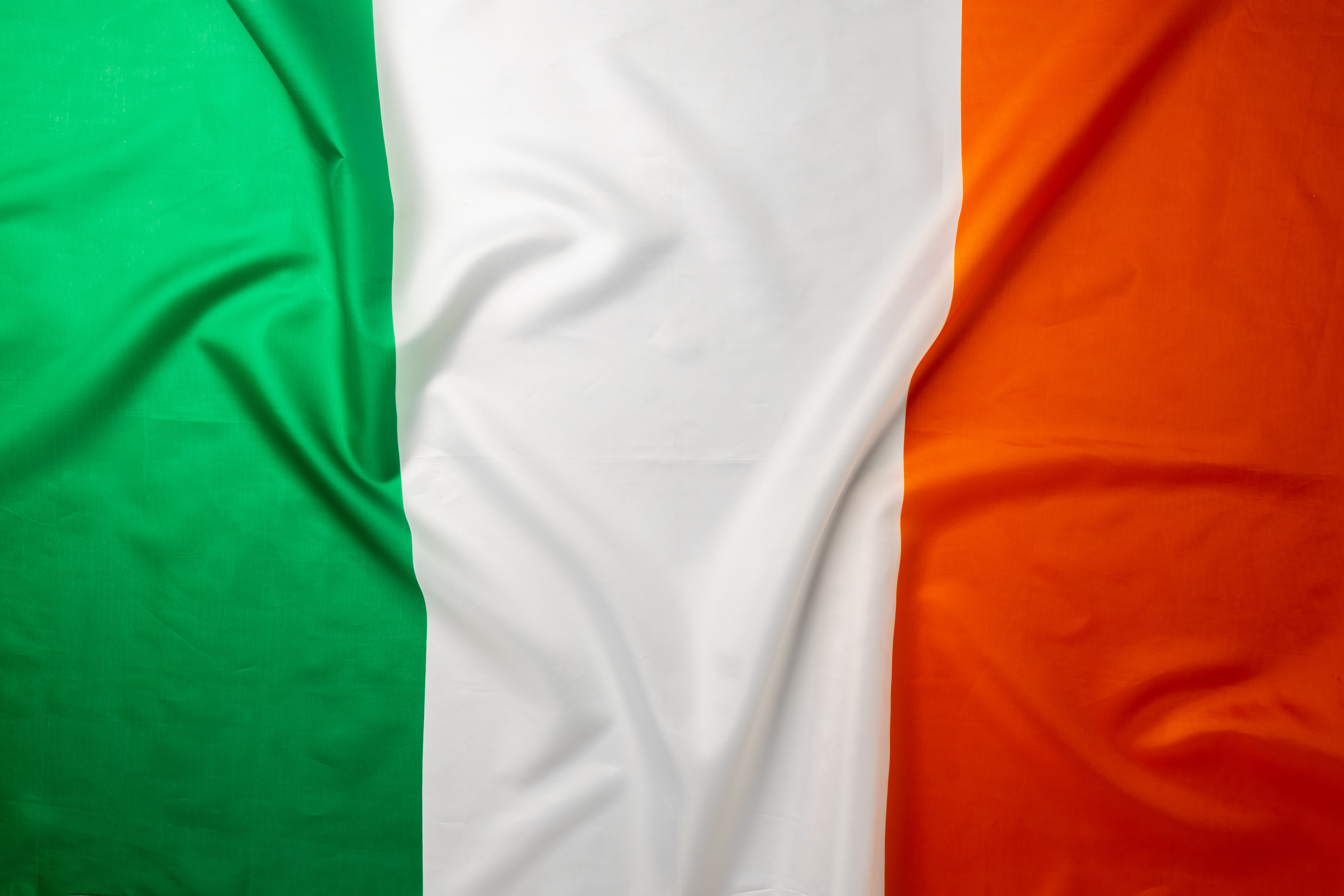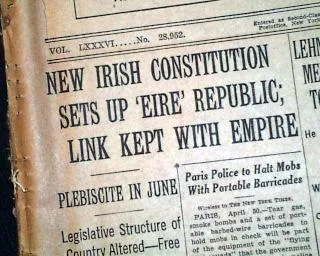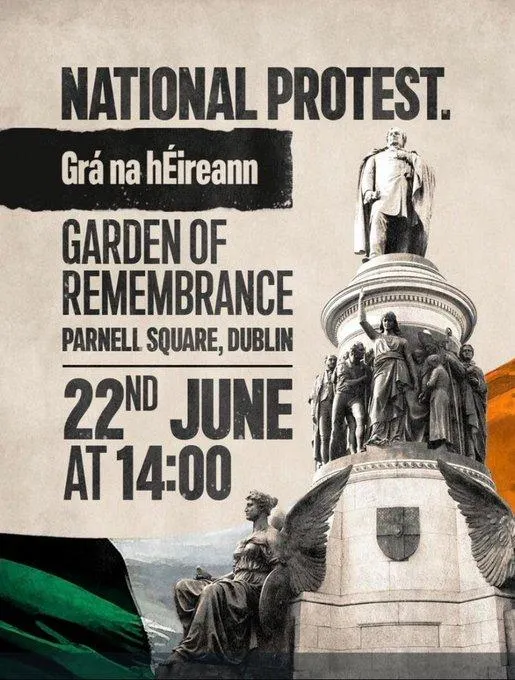
IrishAmericansSupportIreland.com
Mass Immigration - Destroying Irish Culture
Mass Immigration - Creating a Housing Crisis
Globalist Politician - Ignoring Irish Voices, Kneeling to the EU
Crime - Increasing for all cities and towns
NEW THREAT - Censorship from the EU
GARDA AND GOVT OFFICIALS - TAKE ACTION
Have information on the anti-Irish work of Harris, Simon, McEntee, Richmond and other Gombeen EU Overlords from working in the Garda, the Irish Govt or elsewhere.
Send a CONFIDENTIAL EMAIL TO [email protected]
ALL INFORMATION IS CONFIDENTIAL.
CREATE AND SEND YOUR EMAIL FROM A NEW EMAIL ACCOUNT (like Gmail)
KEEP THIS ACCOUNT TO YOURSELF AND READY TO DELETE IT.
THE EU HATE SPEECH LAW MEANS LESS FREEDOM FOR IRISH CITIZENS.
BLOW THE WHISTLE ON GLOBALIST GOMBEENS!

Ireland & America: Comparing Constitutions
Recently, I was on X and challenged about my knowledge of Irish politics by a delusional globalist. Well, when I started seeing the events and outspoken Irish citizens about Ireland's current plight of a housing crisis, immigration and cost of living, I decided to learn. Here are links to the Irish Constitution and the Presidential Election Act. Below is a Grok comparison of them.
I downloaded the Irish Constitution here.
Next, to examine the Irish Presidential Election Act here.
Comparing the US and Irish Constitutions: Individual Rights, Freedoms, and the Collective Good
Overview
The United States Constitution (1787, with the Bill of Rights added in 1791) and the Irish Constitution (Bunreacht na hÉireann, 1937) both enshrine protections for individual rights and freedoms, but they differ significantly in philosophy, structure, and emphasis.
The US document is rooted in Enlightenment liberalism, prioritizing negative rights (freedoms from government interference) and limiting federal power to safeguard individualism. In contrast, the Irish Constitution draws from natural law theory, Catholic social teaching, and a blend of American and European influences, incorporating positive duties on the state to promote rights while explicitly balancing them against the "common good"—a concept emphasizing societal welfare, social justice, and communal obligations.
This leads to a more communitarian approach in Ireland, where individual freedoms are often qualified by collective interests, whereas the US framework treats individual rights as stronger "trumps" against state action. Below, I contrast the two constitutions across key dimensions, drawing on their texts, judicial interpretations, and historical contexts. A table summarizes the key differences for clarity.
Individual Rights
Both constitutions protect core personal rights, such as equality, life, liberty, and privacy, but their scopes and enforcement differ.
US Constitution
Rights are primarily enumerated in the Bill of Rights (Amendments 1–10) and extended via the 14th Amendment (due process and equal protection). These include:
Freedoms of speech, religion, press, assembly, and petition (1st Amendment).
Rights against unreasonable searches (4th), self-incrimination (5th), and cruel punishment (8th).
Due process (5th and 14th Amendments).
The focus is on negative protections: the government must not infringe on these rights.
Unenumerated rights (e.g., privacy in contraception or abortion, via substantive due process) are recognized but narrowly interpreted by the Supreme Court.
Individual rights are paramount, often overriding collective concerns unless a compelling state interest justifies narrow restrictions (e.g., strict scrutiny standard).
The Constitution's preamble mentions promoting the "general Welfare," but this is not a direct limit on rights.
Irish Constitution
Rights are outlined in Articles 40–44, covering:
Equality (Art. 40.1), right to life (Art. 40.3), personal liberty (Art. 40.4), inviolability of the dwelling (Art. 40.5), and freedoms of expression, assembly, and association (Art. 40.6).
Unenumerated rights like bodily integrity, privacy, fair procedures, and earning a livelihood (derived from Art. 40.3).
Unlike the US, Ireland explicitly imposes a positive duty on the state to "protect...as best it can from unjust attack" and "vindicate" these rights (Art. 40.3).
Rights are not absolute; they can be limited by law for the common good, public order, or morality (e.g., privacy limited for child welfare).
Courts balance rights holistically, considering societal context, leading to more state intervention in areas like family protection or social welfare.
Key Contrast:
US rights emphasize autonomy and minimal government intrusion, with individuals bearing primary responsibility for their exercise. Irish rights blend negative protections with state obligations, fostering a relational view where rights support personal flourishing within society.
Freedoms
Freedoms in both documents safeguard personal autonomy, but the US version is more robustly individualistic, while Ireland's is tempered by communal harmony.
US Constitution
Freedoms are framed as shields against government overreach.
The 1st Amendment's speech and religion clauses are broad, protecting even unpopular expression (e.g., hate speech, unless inciting imminent harm).
Freedom of movement and association derive from multiple amendments.
Judicial review (via Marbury v. Madison, 1803) empowers courts to strike down laws infringing freedoms, prioritizing individual liberty over majority will.
Collective good rarely justifies broad curbs; for instance, during emergencies (e.g., WWII internment), courts have later invalidated such actions as rights violations.
Irish Constitution
Freedoms are explicitly qualified:
Freedom of expression (Art. 40.6.1.i) allows "free" voicing of opinions but excludes "sedition, libel, or unjust attack on others' good name" and can be restricted for public order or morality (e.g., blasphemy was formerly prohibited, removed by 2018 referendum).
Assembly (Art. 40.6.1.ii) and association (Art. 40.6.1.iii) rights are peaceful but limited by laws protecting public order.
Unenumerated freedoms like privacy (e.g., marital or informational) are protected but balanced against state duties, such as in abortion (Art. 40.3.3, amended 2018) or data protection.
The state must actively defend freedoms, but courts defer more to legislative judgments on collective needs.
Key Contrast:
US freedoms are presumptively expansive, with the burden on the state to justify limits (e.g., clear and present danger test for speech). Irish freedoms incorporate built-in societal checks, reflecting a Catholic-influenced view of ordered liberty where individual actions must not harm the community.
The 'Collective Good'
This is the starkest divide: the US Constitution downplays explicit collective good in favor of individualism, while Ireland elevates it as a constitutional directive.
US Constitution
The term "common good" or "collective good" is absent from the text.
The preamble references "general Welfare" and "common defence," but these empower government action without subordinating rights.
Early framers (e.g., Madison in Federalist No. 10) designed the system to protect minorities from majority tyranny, viewing collective pursuits as secondary to individual pursuits of happiness.
Some collective elements exist, like the 2nd Amendment's militia for security or taxation for welfare (16th Amendment), but courts interpret these through an individual lens (e.g., DC v. Heller, 2008, affirmed personal gun rights).
Collective good arguments (e.g., for eminent domain) must pass heightened scrutiny and cannot broadly erode rights.
Irish Constitution
The "common good" is foundational, invoked in the preamble (state ordered "in accordance with...the common good") and throughout.
Article 43 delimits property rights "with due regard to the exigencies of the common good."
Directive Principles of Policy (Art. 45, non-justiciable) mandate the state to promote social justice, equitable wealth distribution, and welfare "in order to subserve the common good," drawing from Catholic encyclicals like Rerum Novarum.
The state is the "guardian of the common good," with duties to protect vulnerable groups (e.g., families, Art. 41; children, Art. 42).
Courts use this to justify limits on rights, such as regulating expression for social harmony or acquiring land for public use with compensation.
Key Contrast:
In the US, collective good is implicit and subordinate to rights, promoting a market-driven, individualistic society. In Ireland, it is explicit and superior, guiding state policy toward social solidarity and moral order, with rights as means to communal ends.
Comparative Table
AspectUS ConstitutionIrish ConstitutionPhilosophyLiberal individualism; negative rights limit government.Natural law/communitarianism; positive state duties balance rights with society.Individual RightsEnumerated (Bill of Rights); unenumerated via due process; strong judicial protection.Enumerated (Arts. 40–44) + unenumerated; state must vindicate; holistic balancing.FreedomsBroad, absolutist (e.g., 1st Amendment); limits rare and narrow.Qualified (e.g., for public order/morality); active state defense.Collective GoodMinimal explicit role; rights as trumps (e.g., general welfare in preamble).Central (preamble, Art. 43, directives); limits rights, guides policy.ExamplesSpeech protected unless imminent harm; no state welfare mandate.Expression limited for good name; directives for social justice.
These differences stem from historical contexts: the US as a revolutionary anti-tyranny document, Ireland as a post-colonial blend of sovereignty and social ethics. Both evolve via amendments and interpretation, but Ireland's framework allows more flexibility for collective priorities like welfare, while the US resists them to preserve liberty.
Immigration Video-Ireland
Understand What is Killing Ireland
Nick Delehanty
Eddie Hobbs

Go to "X" and join our community

JUNE 22ND 2pm
Irish Demonstration - Dublin
Garden of Remembrance
Demonstrations are organizing.

Go to "X" and join our community
NO IRISH PRESS FREEDOM
Ben Scallan Reports
https://www.youtube.com/watch?v=eZFH_zFy2kgIndependent media is an essential part of any free society, and is vital for keeping the political establishment in check. But how can journalists hold government politicians to account, when they’re all in bed together - sometimes literally? Ben Scallan investigates.

Go to "X" and join our community
IMMIGRATION
Senator Sharon Keogan Speaks
Senator Keogan speaks on the massive 110,000 person rally held in Dublin on April 26th to keep Irelad for the Irish. The Dail (Parliament) has completely ignored the issue of immigrationn and the voices of the Irish people.
Senator Keogan takes them to task!

Go to "X" and join our community
INVESTIGATE
Young Irish Man Takes Beating
Watch this video. A young Irish man, maybe in County Tipperary, is pushed around and beaten by aother man. Who is he? Did the police (Garda) investigae or ignore it? What about the media?
We believe that both might do NOTHING.
Contribute clues and notes on X now and help.

Go to "X" and contribute clues on this Pinned Post.
get informed. fight for irish sovereignty
Frequently Asked Questions
Learn about the problem to help fight for the Solution.
Question 1: What do you mean "Join the Fight" in Ireland?
Globalists like Micheal Martin and others are kowtowing to the EU and allowing massive immigration - illegal and legal - into Ireland. With no vetting of the immigration. Crime rates have gone way up. The charming streets of Dublin are no more. The Irish government ignores the Irish people's concerns and voices - imposing IPAS immigration centers of hundreds into small towns in Ireland. The result: Devastation of the Irish people and its culture.
Question 2: What can I do as an Irish-American in America?
Take Action! Public pressure to Irish American politicians who recognize the Globalist threat to the Irish culture and Irish people can help. Support Irish politicians in Ireland. Support Irish media (not RTE!) and fight for the Irish people. We have a list! We are working on action points too that you could undertake to help the good For the Irish politicians and other activists.
Question 3: Who are these Globalists and what is their agenda?
Globalists in Irish government include many officials who disdain or outright hate the concept of Irish sovereignty and nationhood. Ireland fought repression and genocide for 800 years and its people are not going to surrender to the EU crowd. Prominent globalists Irish politicians (we have a list!) are Micheal Martin, Simon Harris, Helen McEntee, Neale Richmond and more. They are gombeens, an Irish word for a greedy person who looks out for themselves to make money. And the Irish illegal and legal immigration industry is full of these gombeens.
Question 4: What if I do nothing?
Ireland and the Irish culture will be gone. Some projections indicate, with unchecked immigration, that the native Irish people will be a minority in their own country in 10 years. When your grandchildren want to hear the story of how you helped save Ireland, have something to tell them!

X